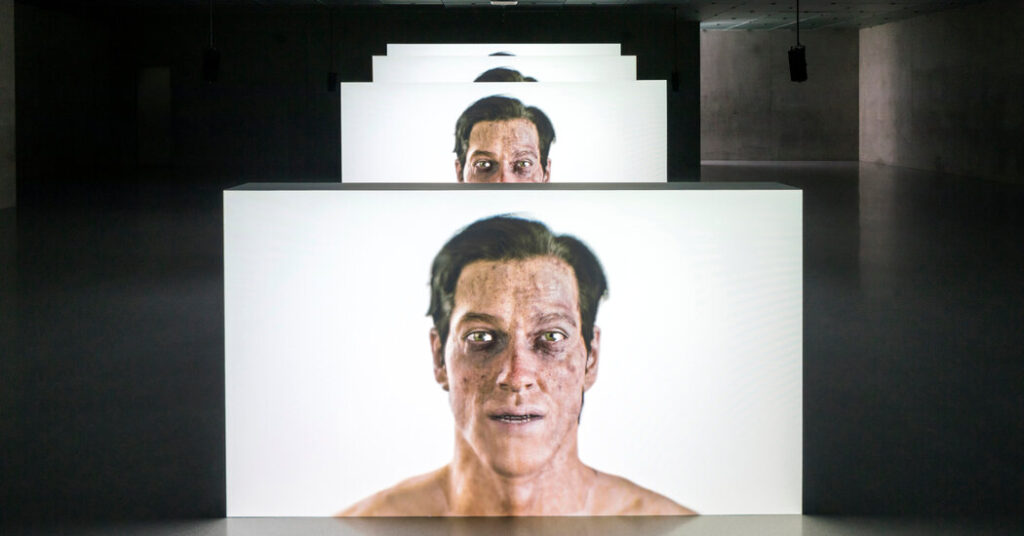It’s awful having a body. It oozes, leaks, spurts. It is unpredictable, uncontrollable, ails, fails, betrays and embarrasses. It’s not nice to admit, but you know it, and I know it. The artist Ed Atkins definitely knows it.
A major new retrospective of Atkins’s work, running at Tate Britain in London through Aug. 25, features human bodies (or digital versions of them) that are anxious, lost for words, exhausted, emotional, apologetic and falling to pieces, sometimes quite literally.
Atkins — who was born in Oxford, England, in 1982 and is based in Copenhagen — is perhaps best known for his videos that show CGI avatars in strange states of limbo. They utter disjointed but poetic narratives, or try and fail to perform various tasks — as though struggling to be “real.”
An early film at Tate Britain, “Death Mask II: The Scent” (2010), alternates between scenes of digital devices, a human head, shot from behind, with short blonde locks bathed in neon light, and close-ups of a fruit from various angles as sticky liquid pours over its eerie skin, which is pocked and freckled like an aged human’s. Here, it is the editing process, with jump cuts visible to the viewer, that creates an uncanny tension.
In “Hisser” (2015), simultaneously projected on three free-standing walls that increase in size, we enter a more recognizable environment: a teenage bedroom (remember that kitten poster that urged us to “hang in there”?), with moonlight streaming through an open window. A man appears on the bed, tossing and turning, and singing to himself. He flips through a stack of Rorschach blots, masturbates to a postcard of a Walter Sickert painting, browses his computer — and then falls through the floor into a giant sinkhole, only to reappear, walking naked and disoriented, stumbling and mumbling through a bright white nothingness.
There’s a morbid humor to Atkins’s work, which puts its avatars — based on the artist’s own facial gestures and speech, recorded and mapped using motion capture technology — through excruciating experiences. A wall text by the artist explains that “Hisser” was inspired by the news story of a man in Florida who disappeared when his bedroom was swallowed by a sinkhole.
“This idea attracted and consoled me,” writes the artist, who also describes the film as an exorcism of sorts, and its characters as “surrogates” or “emotional crash-test dummies” who reckon with things that Atkins himself cannot face. And yet they remain imperfect stand-ins, not quite real, if “real” means convincing, or lifelike.
Well, who can blame them? They can, after all, only learn what their makers teach them. They are, we see in Atkins’s work, like us: limited. In his world, technology doesn’t create utopias; it mirrors who we are, inside and out.
This becomes more obvious as the show progresses. Near the end, a video called “Pianowork 2” (2023) features a digitally generated character who looks just like Atkins, playing an exacting piece by the composer Jürg Frey on an upright piano in a darkened studio. Atkins’s avatar grimaces, gasps, frowns, smiles and sighs — and as he struggles with the precise minimalism of the piece, seems to transcend the moment now and again, as performers sometimes can.
The Tate Britain show presents Atkins’s video work chronologically, but it is surrounded by newer work in other mediums — drawings, sculptures, installations — and the retrospective has a fluid mood, rather than seeming like a linear tour. “Beds” (2025), features a pair of beds, whose white covers writhe as if possessed by some invisible animating process.
In “Old Food” (2017-2018), Atkins has installed a series of videos between huge racks of costumes borrowed from the Deutsche Oper opera house in Berlin. Screens show a baby, a boy and a man sobbing; thick tears, more like glue than saline — another technological limitation — run down their faces. All around them, velvet robes, starched crinolines and silver dresses hang heavy, like speechless ghosts of dramas past.
The most recent works are Atkins’s most personal. “Children” (2020-ongoing) features touching grids of drawings on Post-it notes that the artist put into his daughter’s lunchbox. They are colorful, profane, comical, full of “I love you”s and sometimes written in childish scrawl: a record of the tender, fleeting moment of early-childhood parenting.
“Nurses Come and Go, but None for Me” (2024), a collaboration with the poet Steven Zultanski, is also about love, the passing of time and loss. The two-hour film features the actor Toby Jones reading a diary that Atkins’s father kept during the six months before his death from cancer in 2009. A room of young people listens. One sobs. They all fidget. We watch their faces, and they are as unfathomable as those of the digital avatars we’ve scrutinized in previous rooms.
At the end of the film, which is the end of the diary, the actress Saskia Reeves mimes an ambulance driver who tries to heal Jones with a series of magical concoctions, before covering his body with Post-it notes scrawled with enigmatic symbols — a game Atkins plays with his daughter.
The film allows us to hope, beyond reason, that the diary perhaps hasn’t ended, that the pain will dissipate and that everything will be all right again. There’s no sinkhole, no cure — there’s just life and, of course, art. In Atkins’s work, no matter the medium, those forces are realer than real.
https://www.nytimes.com/2025/04/02/arts/design/ed-atkins-tate-britain.html


